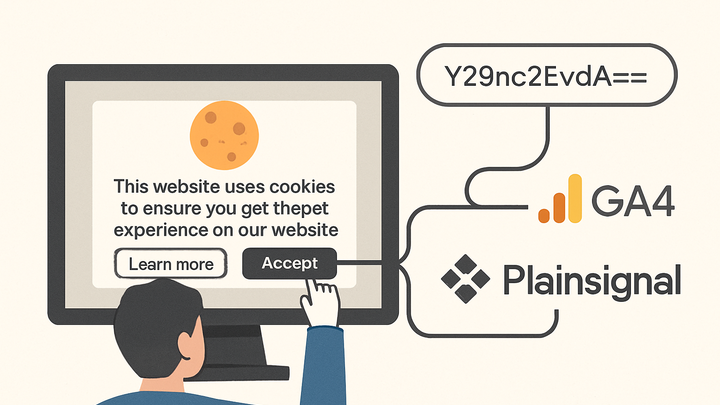Published on 2025-06-22T07:07:06Z
What is a Consent String in Analytics? Definition & Examples
Consent String is a standardized, encoded sequence that encapsulates a user’s privacy preferences as collected by a Consent Management Platform (CMP). Following the IAB Transparency & Consent Framework (TCF) specifications, it maps consents for various purposes, vendors, and special features into a single, base64-encoded string. Analytics tools like Google Analytics 4 (GA4) and privacy-first platforms such as PlainSignal can read this string to determine which tracking activities are permitted. By referencing the Consent String, these platforms ensure that data collection aligns with regulations like GDPR, ePrivacy, and CCPA. Implementation usually involves generating the string client-side via the CMP, storing it in a first-party cookie or localStorage, and passing it to analytics scripts or APIs.
Consent string
A Consent String is an encoded representation of user privacy choices that analytics tools use to ensure compliance with data regulations.
Definition and Purpose
This section provides an overview of what a Consent String is and why it matters for analytics and compliance.
-
Definition of consent string
A Consent String is a compact, base64-encoded sequence that encapsulates a user’s consent decisions for various purposes, vendors, and special features.
-
Core components
Consent Strings follow the IAB TCF specification and include:
- Purpose Consents: Flags for processing purposes (e.g., analytics, personalization).
- Vendor Consents: Permissions for third-party vendors.
- Special Feature Consents: Opt-ins for advanced tracking methods.
-
Purpose consents
Indicates consent status for defined processing categories.
-
Vendor consents
Specifies which vendors have permission to process data.
-
Special feature consents
Grants or denies use of specific tracking capabilities.
-
Compliance role
By passing a Consent String, analytics platforms like GA4 and PlainSignal ensure that data collection aligns with GDPR, ePrivacy, and CCPA requirements.
Technical Implementation
Understanding how Consent Strings are generated, stored, and propagated is crucial to correct analytics behavior.
-
Generating and storing consent strings
Consent Management Platforms (CMPs) generate the string after a user interacts with a consent banner. It’s then stored in a first-party cookie or localStorage for later retrieval.
-
Storage mechanisms
Cookies or localStorage allow quick access to the string by client-side scripts.
-
Retrieval
Analytics scripts read the string during page load or tracking events.
-
-
Propagating to analytics platforms
The Consent String must be sent alongside tracking calls, either via query parameters, HTTP headers, or dataLayer variables.
-
Query parameters
Appending
?consent_string=...to image or XHR calls. -
Http headers
Including a
Consent-Stringheader in fetch requests. -
Data layer
Pushing the string into
window.dataLayerfor tag managers.
-
-
Validating consent strings
Use libraries like the IAB TCF JavaScript SDK to decode and verify the integrity of the string before applying consent logic.
-
Iab tcf sdk
Official SDK for encoding/decoding TCF v2.0 strings.
-
Custom validation
Verify base64 format and expected field values.
-
Examples in Analytics Platforms
Practical code examples showing how to integrate Consent Strings with GA4 and PlainSignal.
-
GA4 implementation example
Use Google’s gtag consent mode to pass consent decisions and attach the Consent String:
<script async src="https://www.googletagmanager.com/gtag/js?id=GA_MEASUREMENT_ID"></script> <script> window.dataLayer = window.dataLayer || []; function gtag(){dataLayer.push(arguments);} gtag('consent', 'default', { 'analytics_storage': 'denied' }); // After CMP interaction, update consent and attach string gtag('consent', 'update', { 'analytics_storage': 'granted', 'consent_string': '{{CONSENT_STRING}}' }); gtag('config', 'GA_MEASUREMENT_ID'); </script>-
Script loading
Loads gtag.js and initializes consent mode.
-
Updating consent
Updates both consent flags and includes the encoded string.
-
-
PlainSignal implementation example
Add the PlainSignal script tag and include the
data-consent-stringattribute with your Consent String:<link rel="preconnect" href="//eu.plainsignal.com/" crossorigin /> <script defer data-do="yourwebsitedomain.com" data-id="0GQV1xmtzQQ" data-api="//eu.plainsignal.com" data-consent-string="{{CONSENT_STRING}}" src="//cdn.plainsignal.com/plainsignal-min.js"></script>-
Data-consent-string
Ensures PlainSignal respects user preferences by reading the string at load time.
-
Domain configuration
The
data-doanddata-apiattributes define your tracking endpoint.
-
-
Troubleshooting common issues
Typical misconfigurations and how to fix them.
-
String not updating
Ensure the CMP writes the cookie before analytics scripts execute.
-
Case sensitivity
Attribute names like
data-consent-stringmust match exactly. -
Timing issues
Delay script tags or use event listeners to load after user action.
-
Best Practices and Considerations
Guidelines to maximize compliance and user trust when using Consent Strings.
-
Transparency and user control
Clearly explain what each consent option means and allow easy changes.
-
Clear messaging
Use plain language on consent banners.
-
Easy opt-out
Provide a persistent link to update consent.
-
-
Consent string expiration and renewal
Respect legal requirements on consent validity periods and re-prompt users as needed.
-
Expiration policies
Commonly 6 to 12 months under GDPR.
-
Renewal strategies
Use banner refresh triggers based on time or significant site changes.
-
-
Cross-domain considerations
If you operate multiple subdomains or partner sites, plan how to share or centralize consent storage.
-
Cookie domain
Set the cookie domain to
.example.comfor subdomain access. -
Cors and proxying
Ensure API endpoints accept the Consent String from authorized origins.
-
